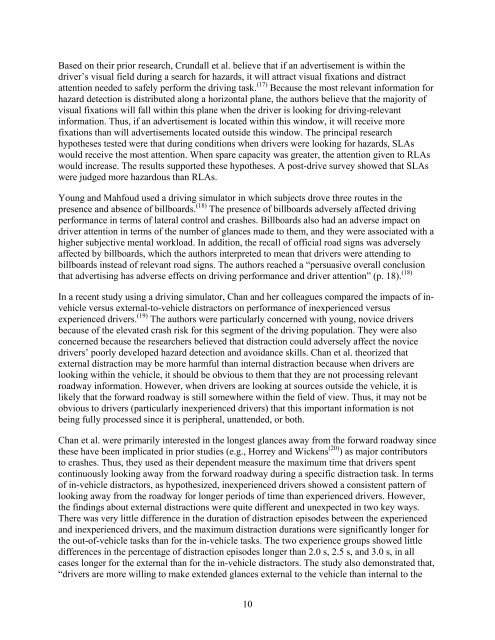The Effects of Commercial Electronic Variable Message Signs ...
The Effects of Commercial Electronic Variable Message Signs ...
The Effects of Commercial Electronic Variable Message Signs ...
You also want an ePaper? Increase the reach of your titles
YUMPU automatically turns print PDFs into web optimized ePapers that Google loves.
Based on their prior research, Crundall et al. believe that if an advertisement is within the<br />
driver’s visual field during a search for hazards, it will attract visual fixations and distract<br />
attention needed to safely perform the driving task. (17) Because the most relevant information for<br />
hazard detection is distributed along a horizontal plane, the authors believe that the majority <strong>of</strong><br />
visual fixations will fall within this plane when the driver is looking for driving-relevant<br />
information. Thus, if an advertisement is located within this window, it will receive more<br />
fixations than will advertisements located outside this window. <strong>The</strong> principal research<br />
hypotheses tested were that during conditions when drivers were looking for hazards, SLAs<br />
would receive the most attention. When spare capacity was greater, the attention given to RLAs<br />
would increase. <strong>The</strong> results supported these hypotheses. A post-drive survey showed that SLAs<br />
were judged more hazardous than RLAs.<br />
Young and Mahfoud used a driving simulator in which subjects drove three routes in the<br />
presence and absence <strong>of</strong> billboards. (18) <strong>The</strong> presence <strong>of</strong> billboards adversely affected driving<br />
performance in terms <strong>of</strong> lateral control and crashes. Billboards also had an adverse impact on<br />
driver attention in terms <strong>of</strong> the number <strong>of</strong> glances made to them, and they were associated with a<br />
higher subjective mental workload. In addition, the recall <strong>of</strong> <strong>of</strong>ficial road signs was adversely<br />
affected by billboards, which the authors interpreted to mean that drivers were attending to<br />
billboards instead <strong>of</strong> relevant road signs. <strong>The</strong> authors reached a “persuasive overall conclusion<br />
that advertising has adverse effects on driving performance and driver attention” (p. 18). (18)<br />
In a recent study using a driving simulator, Chan and her colleagues compared the impacts <strong>of</strong> invehicle<br />
versus external-to-vehicle distractors on performance <strong>of</strong> inexperienced versus<br />
experienced drivers. (19) <strong>The</strong> authors were particularly concerned with young, novice drivers<br />
because <strong>of</strong> the elevated crash risk for this segment <strong>of</strong> the driving population. <strong>The</strong>y were also<br />
concerned because the researchers believed that distraction could adversely affect the novice<br />
drivers’ poorly developed hazard detection and avoidance skills. Chan et al. theorized that<br />
external distraction may be more harmful than internal distraction because when drivers are<br />
looking within the vehicle, it should be obvious to them that they are not processing relevant<br />
roadway information. However, when drivers are looking at sources outside the vehicle, it is<br />
likely that the forward roadway is still somewhere within the field <strong>of</strong> view. Thus, it may not be<br />
obvious to drivers (particularly inexperienced drivers) that this important information is not<br />
being fully processed since it is peripheral, unattended, or both.<br />
Chan et al. were primarily interested in the longest glances away from the forward roadway since<br />
these have been implicated in prior studies (e.g., Horrey and Wickens (20) ) as major contributors<br />
to crashes. Thus, they used as their dependent measure the maximum time that drivers spent<br />
continuously looking away from the forward roadway during a specific distraction task. In terms<br />
<strong>of</strong> in-vehicle distractors, as hypothesized, inexperienced drivers showed a consistent pattern <strong>of</strong><br />
looking away from the roadway for longer periods <strong>of</strong> time than experienced drivers. However,<br />
the findings about external distractions were quite different and unexpected in two key ways.<br />
<strong>The</strong>re was very little difference in the duration <strong>of</strong> distraction episodes between the experienced<br />
and inexperienced drivers, and the maximum distraction durations were significantly longer for<br />
the out-<strong>of</strong>-vehicle tasks than for the in-vehicle tasks. <strong>The</strong> two experience groups showed little<br />
differences in the percentage <strong>of</strong> distraction episodes longer than 2.0 s, 2.5 s, and 3.0 s, in all<br />
cases longer for the external than for the in-vehicle distractors. <strong>The</strong> study also demonstrated that,<br />
“drivers are more willing to make extended glances external to the vehicle than internal to the<br />
10

















